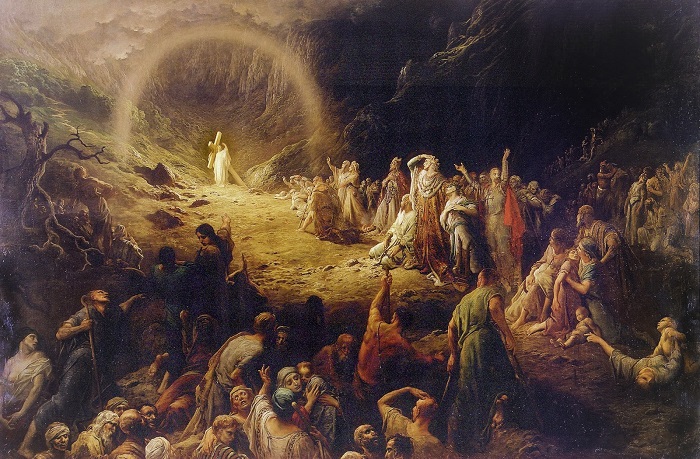Question:
In Mathew 27:52-53, the Bible says that when Christ died on the cross, graves were opened, and many of the saints who had fallen asleep were raised. Where these saints still captives of the devil? What were the criteria of Old Testament righteousness, and why were these saints still captives? I thought they were supposed to be in Abraham’s bosom but not underground.
To address the question of how Old Testament saints were saved, please refer to the following study: How were people saved in the Old Testament? – Endofthematter.com
Matthew 27:50-53 says, “And Jesus cried out again with a loud voice and yielded up his spirit. And behold, the curtain of the temple was torn in two, from top to bottom. And the earth shook, and the rocks were split. The tombs also were opened. And many bodies of the saints who had fallen asleep were raised, and coming out of the tombs after his resurrection they went into the holy city and appeared to many.”
At the death of Jesus on the cross, immediately the temple curtain was torn, followed by an earthquake. As a result, the rocks were split, and tombs were opened. These tombs were of the saints or the “Holy ones”. The Bible does not identify any of the resurrected saints. Because the bodies were still in the graves, it is speculated these were probably more recent believers in the inter-testament period than the Old Testament patriarchs. When they went into the holy city (Jerusalem) at their resurrection, many would have recognised them and witnessing and attesting to their appearance of being alive.
Before the death and resurrection of Christ, the Old Testament believers went to Sheol (also called Hades in the New Testament). Sheol/Hades was the realm of the dead, and both the wicked (Isaiah 5:14, Psalm 9:17) and the righteous (Job 14:13; Psalm 88:3) went there. Hades is divided into two, where one section is a place of comfort and the other a place of torment before the resurrection of Christ. In Luke 16:19-31, we read the story of Lazarus and the rich man. In this account, we see that Lazarus went to the place of comfort, also known as Abraham’s bosom or Abraham’s side. In contrast, the rich man went to the area of torment, also known as “Gehenna” (Mark 9:45). There is a great chasm that separates the two according to Luke 16:26.
The Bible does not fully reveal the location of Hades. Many speculate that Hades is in the centre of the earth because of passages such as Luke 10:15 or 1 Samuel 28:13-15. Also, in Ephesians 4:9-10, it says, “(In saying, “He ascended,” what does it mean but that he had also descended into the lower regions, the earth? He who descended is the one who also ascended far above all the heavens, that he might fill all things.).” Reading this passage carefully talks about Jesus coming to the earth in reference to His incarnation and not the location of His death. He ascended into heaven, and it had been to the earth he descended. John 3:13 says, “No one has ascended into heaven except he who descended from heaven, the Son of Man.” So, the scriptures do not really reveal the exact location of hell. Wherever the location, we know that Hades had two compartments. One of comfort and the other of torment.
Until the death and resurrection of Christ, the Old Testament saints went to Sheol. The reason for this was that no one could be admitted to heaven because of sin. Their sins were not atoned for, so they had to wait for this barrier to be removed. Until then, they were still captive to sin until full payment of sin was made to God. Christ’s sacrifice of Himself on the cross took away this barrier. Jesus, at His ascension, emptied the righteous out of Hades and led them into the presence of God the Father, while the unrighteous were left in the place of torment. Ephesians 4:8-10 says, “Therefore it says, “When he ascended on high he led a host of captives, and he gave gifts to men.” (In saying, “He ascended,” what does it mean but that he had also descended into the lower regions, the earth? He who descended is the one who also ascended far above all the heavens, that he might fill all things.).”
The Apostle Paul quotes Ephesians 4:8 from Psalm 68:4 and applies it to the ascension of Christ. To get a clearer understanding of its meaning, let us look at John MacArthur’s comments on Psalm 68 and Ephesians as follows:
“is a victory hymn composed by David to celebrate God’s conquest of the Jebusite city and the triumphant ascent of God (represented by the Ark of the Covenant) up Mount Zion (cf. 2 Sa. 6-7; 1Chr 13). After a king won such a victory he would bring home the spoils and enemy prisoners to parade before his people. An Israelite king would take his retinue through the holy city of Jerusalem and up Mount Zion.
Another feature of the victory parade, however, would be the display of the king’s own soldiers who had been freed after being held prisoner by the enemy. These were often referred to as recaptured captives—prisoners who had been taken prisoner again, so to speak, by their own king and given freedom.” (MacArthur, J: Ephesians. Chicago: Moody Press).
Likewise, Christ conquered all spiritual enemies by which we were being held captive, such as sin, Satan, and death. Colossians 2:13-15 says, “And you, who were dead in your trespasses and the uncircumcision of your flesh, God made alive together with him, having forgiven us all our trespasses, by canceling the record of debt that stood against us with its legal demands. This he set aside, nailing it to the cross. He disarmed the rulers and authorities and put them to open shame, by triumphing over them in him.” We are no longer slaves to sin; instead, we are slaves to righteousness (Romans 6:18). Jesus now has the keys to death and Hades. Revelation 1:18 says, “… I died, and behold I am alive forevermore, and I have the keys of Death and Hades.” Amen!
Now, when believers in the Lord Jesus Christ die, they will be present with the Lord immediately in heaven along with the Old Testament saints who are also now in heaven (2 Corinthians 5:6-9). Whereas when an unbeliever dies, they will go to Hades, to the place of torment. At the final Great White Throne judgement, Hades and all the people in it will be emptied into the lake of fire (Revelation 20:13-15).



